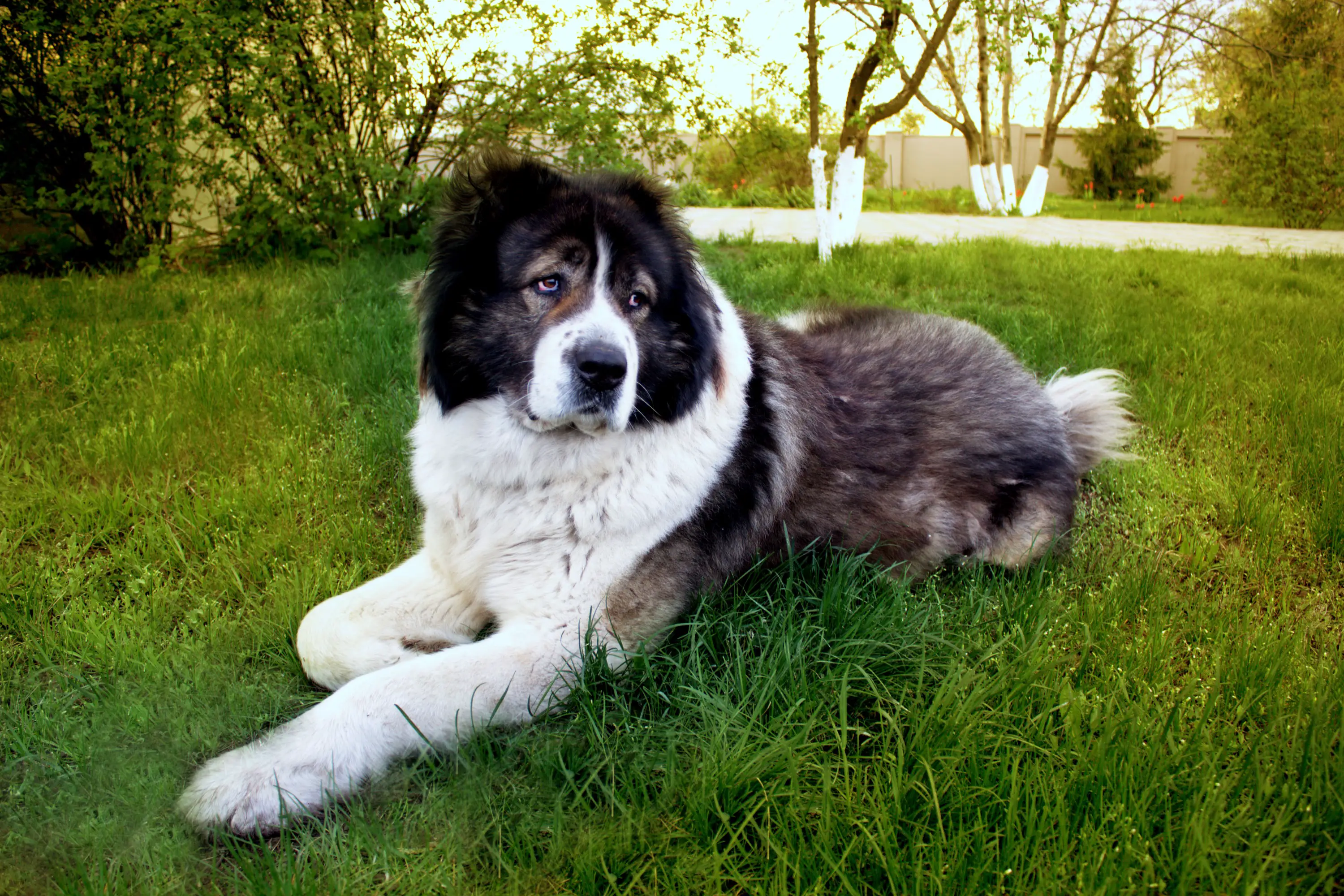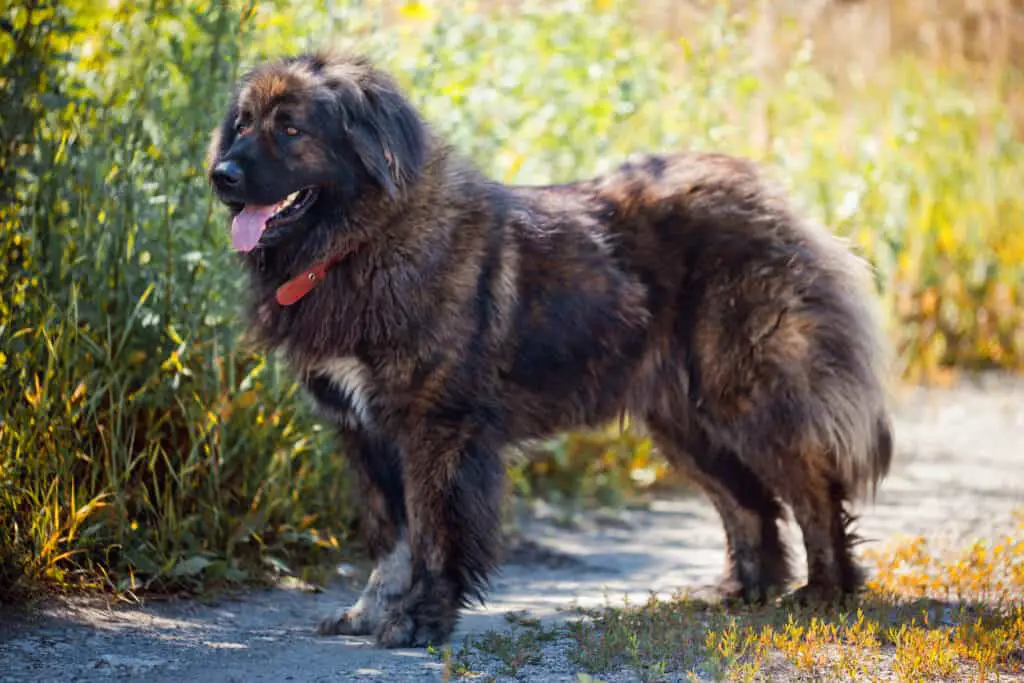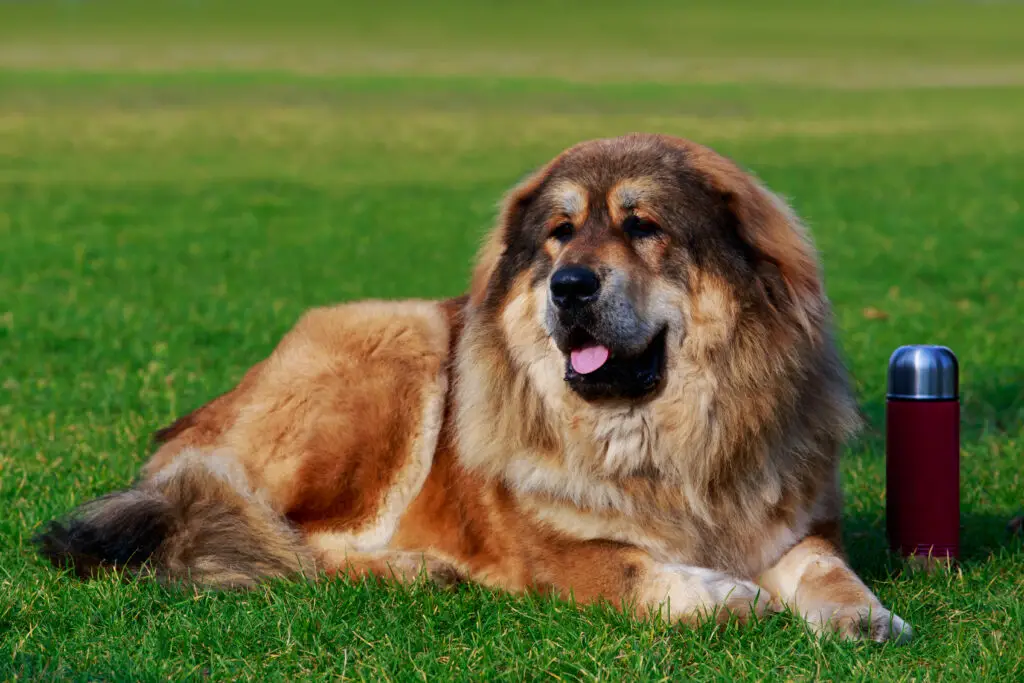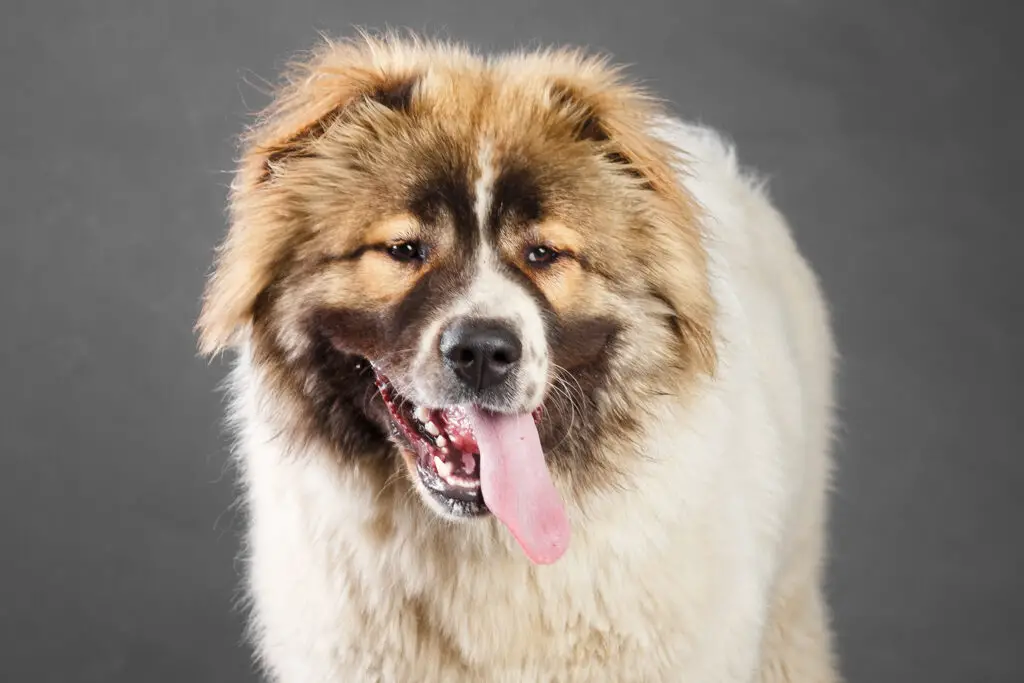Our website is supported by our users. We sometimes earn money when you click an affiliate link and make a purchase. This is at no extra cost to you and helps us to create quality content. Thank you for your support. For all that have shown us such wonderful support, we thank you from the bottom of our hearts!
The Caucasian Shepherd Dog is a remarkable breed known for its size, strength, and protective instincts.
Originally bred in the Caucasus mountains to guard livestock against predators, these dogs are distinguished by their fearlessness and loyalty.
Known for their thick coats and robust build, Caucasian Shepherds are well-equipped to withstand harsh climates and challenging terrains.
With a presence as commanding as their history, they make for both formidable guardians and loyal family members.

Training and socialization are crucial in harnessing the Caucasian Shepherd’s natural protective behavior and ensuring they become well-adjusted pets.
Due to their innate guarding traits, a well-informed approach towards training is essential, emphasizing positive reinforcement and firm, consistent commands.
Potential owners should be aware of the breed’s considerable grooming needs and potential health issues, which necessitate regular care.
Understanding these aspects is key to ensuring the well-being of a Caucasian Shepherd.
Key Takeaways
- The Caucasian Shepherd Dog is a large, protective breed with a history as livestock guardians.
- Proper training and socialization are essential for integrating these dogs into a family setting.
- Regular grooming and awareness of health issues are important for maintaining the breed’s well-being.
History of the Caucasian Shepherd
The Caucasian Shepherd, also known as the Caucasian Ovcharka, has a storied past anchored in the rugged Caucasus Mountains.
With roots dating back to ancient times, this breed has been the guardian of choice for protecting livestock from predators.
Originally, your Caucasian Shepherd’s ancestors were central to the pastoral communities of the Caucasus.
They developed a reputation as fearless protectors, earning respect for their large size, strength and endurance.
Throughout time, these dogs have been shaped by the harsh mountainous climate and challenging landscape, which forged them into the powerful guardians they are today.
In the early 20th century, the breed became more standardized.
The Soviet Union took a vested interest in these dogs, using them for guarding government facilities and national borders.

Your Caucasian Shepherd originated to fulfill a pivotal role: to protect properties and to stand as a stalwart against trespassers and wild animals.
There have been two breed kinds and standards: the Steppe type, which has a shorter coat and a smaller body mass, and the Mountain type, which has a longer coat and a higher body mass.
Here’s a brief chronology highlighting key points in your breed’s history:
- Ancient Times: The breed’s early ancestors are used by shepherds in the Caucasus to protect flocks.
- 1920s: Formal development in the Soviet Union leads to breed standards.
- Post-World War II: Russian efforts preserve and refine the breed.
- Present Day: The Caucasian Shepherd is admired for its loyal and protective nature globally.
The AKC classification for purebreds of breeds that the AKC does not recognize is FSS (Foundation Stock Service). In this instance, the AKC only recognizes Caucasian Mountain Dogs often known as Caucasian Shepherds, Ovcharkas for FSS which is part of the American Kennel Club.
This breed, however, was fully recognized by the United Kennel Club in 1995.
Your dog’s lineage is said to be traced back to ancient Tibetan dogs, showing the vast journey that these dogs have made to become the Caucasian Shepherds of today.
These historical guardians are now renowned for their loyalty to family, serving not only as protectors but as cherished companions.
Physical Characteristics of the Caucasian Shepherd

The Caucasian Shepherd is a large and powerful breed, known for its thick double coat and prominent, muscular build.
It is well-regarded for its capabilities as a shepherd and guard dog, with its size and strength being defining attributes. Below is a detailed breakdown of its physical characteristics.
Height Male
Males typically stand between 23 to 30 inches at the shoulder, reflecting their large size.
Height Female
Females are slightly smaller, with a standard height ranging from 23 to 28 inches.
Weight Male
A healthy male German Shorthaired Pointer has a weight that usually falls between 110 to 220 pounds.
Weight Female
Female GSPs are generally lighter, with weights ranging from 110 to 180 pounds.
Eye Colors
The eyes are often almond-shaped and may come in various shades, commonly exhibiting Dark to lighter brown hues that convey an alert and intelligent expression.

Coat Colors
Your Caucasian Shepherd can exhibit a variety of coat colors including, but not limited to:
- Black
- Gray
- Fawn
- Cream
- Red
- Rust
- White with or without markings
- Brindle
Coat Types
The Caucasian Shepherd has a medium-length double-coat that is both functional for outdoor activities and easy to maintain, typically being slightly coarse to the touch.
Life Expectancy
With proper care, your Shepherd can be expected to live 10 to 12 years, enjoying a life full of activity and companionship.
Overview
When you first meet a Caucasian Shepherd, you’ll immediately notice their impressive stature.
Typically, males are larger than females, but both genders possess a notable presence.
Their weight reflects their muscular and robust frame, contributing to their guardian role.
The double coat, dense and providing protection against harsh weather, comes in an array of colors and may have white markings or brindle patterns.
Their lifespan is similar to other large breeds, and they carry an aura of strength and confidence.
Temperament & Training of the Caucasian Shepherd
Temperament: The Caucasian Shepherd dog is known for its protective and strong-willed nature, often used as a guardian for the property and livestock due to its vigilant and independent temperament.
These dogs are loyal and kind to their families but may be wary of strangers.
Their history as guardians influences their behavior, making them dedicated and courageous when it comes to protecting their pack.
Training: Training your Caucasian Shepherd requires patience and consistency.
Begin obedience training and socialization early, as this giant breed can be quite independent making training more challenging.
You must establish yourself as the pack leader—with a confident and knowledgeable approach—because Caucasian Shepherds are strong-willed dogs and may not be suitable for a first-time dog owner.
- Patience is crucial; they respond well to calm and assertive commands.
- Positive reinforcement helps encourage desired behavior.
- Training should be a blend of firmness and kindness.
Used by the Soviet government to protect factories, they make excellent border control dogs.
Exercise Needs: A considerable amount of exercise is necessary to manage their physical and mental health.
You need to ensure that your Caucasian Shepherd gets regular workouts which can include long walks, time in a fenced yard, or playtime to burn off energy.
Socialization: Proper socialization with other dogs and people is key, as this breed’s protective nature can lead to aggression if not correctly managed.
| Key Training Aspects | Notes |
|---|---|
| Obedience Training | Essential to manage their independent streak |
| Socialization | Prevents aggression and helps with wariness around strangers |
| Exercise Needs | Vital for physical and mental well-being |
Your consistent training and socialization, combined with understanding their temperament, will help in raising a well-behaved Caucasian Shepherd.
Health Issues of the Caucasian Shepherd

When considering the health of the Caucasian Shepherd, being aware of common conditions is key to maintaining their well-being.
Regular veterinary check-ups are essential in detecting and managing health issues early.
Hip and elbow dysplasia
Hip and elbow dysplasia are inheritable conditions often seen in larger breeds like the Caucasian Shepherd.
This involves the abnormal development of the respective joints, which can lead to discomfort and mobility issues.
Mitigating such risks involves ensuring your dog maintains a healthy weight to reduce stress on the joints.
Entropion
Entropion, where the eyelid rolls inward, can affect this breed, causing eye irritation or injury.
Recognition and surgical correction by a veterinarian can effectively address this problem.
Bloat
Another serious condition that can impact large dogs is bloat, or gastric torsion.
It’s an emergency that causes the stomach to expand with gas and twist, requiring immediate medical attention.
Obesity
Lastly, be mindful of obesity in your Caucasian Shepherd.
Excess weight can exacerbate joint problems and contribute to additional health problems.
Implementing a balanced diet and regular exercise routine will help keep your dog healthy and active.
| Common Health Issues | Description | Prevention Strategies |
|---|---|---|
| Hip Dysplasia | Joint malformation that can lead to arthritis | Maintain healthy weight, appropriate exercise |
| Elbow Dysplasia | Similar to hip dysplasia, affecting the elbow | Weight management, nutritional support |
| Entropion | Eyelid turns inward | Surgical intervention if necessary |
| Bloat | Stomach fills with gas, potentially twisting | Feed smaller, frequent meals, avoid vigorous exercise after eating |
| Obesity | Excess body weight | Proper diet, regular physical activity |
Monitoring your dog’s health with routine health assessments can help spot these issues before they become severe.
Grooming Your Caucasian Shepherd
Proper grooming is essential for maintaining your Caucasian Shepherd’s thick double coat and overall health.
Regular brushing, bathing, and other grooming tasks will ensure your dog looks and feels their best.
Brushing
To manage shedding and keep their coat healthy, you may consider daily brushing to remove loose fur.
Use a long-bristled brush or a rake to reach deep into their dense fur, helping to prevent mats and tangles.
Bathing
Bathing your dog too frequently can dry out their skin, but a bath every 3-4 months is advisable for keeping their coat clean.
Always use a shampoo formulated for dogs with double coats to maintain the natural oils that protect their skin.
This massager really gets the soap and all of it’s soothing ingredients down through your Caucasian Shepherds thick fur to it’s skin.
Cutting Fur/Hair
Despite their long fur, it’s often not necessary to cut a Caucasian Shepherd’s hair.
However, trimming around the feet and hocks can keep them tidy.
Only trim when necessary to prevent burrs or debris from getting caught.
Clipping or Grinding Nails
To avoid overgrowth that can lead to discomfort or even injury, check your dog’s nails monthly.
Clip or grind them as needed, allowing your dog to walk comfortably. This grinder has a guard that is appropriate for larger dogs.
If you accidentally cut the quick, dip their nails in Styptic Powder.
Also, you can check out our article on How to Grind Your Dog’s Nails.
And How to Clip Your Dog’s Nails Safely.
Dental Care
Brush your dog’s teeth several times a week to prevent dental issues and bad breath. Use a toothbrush and toothpaste specifically designed for dogs for best results.
Cleaning Ears
Gently clean your Caucasian Shepherd’s ears regularly to remove any buildup and prevent ear infections. A simple wipe with a damp cloth or a dog-specific ear cleaner is usually sufficient.
Pet MD – Dog Ear Cleaner Wipes – Otic Cleanser for Dogs are a convenient solution.
Owning a Caucasian Shepherd
Owning a Caucasian Shepherd dog involves significant financial commitment and a deep understanding of the breed’s needs.
These formidable guardians require careful training, adequate space, and can be a powerful addition to families when properly socialized.
Cost of Purchase
The initial cost of purchasing a Caucasian Shepherd can range significantly depending on the breeder and the dog’s lineage.
Expect to pay anywhere from $1,000 to $3,000 for a well-bred Caucasian Shepherd from a reputable breeder.
Bear in mind that puppies from champion bloodlines may cost even more.
Maintenance Costs
Ongoing maintenance costs for a Caucasian Shepherd include food, grooming, medical costs, and training.
Given their size, you can anticipate monthly food expenses to exceed $50, with premium brands that cater to large, active dogs.
For grooming, a sturdy grooming toolkit is necessary to manage their thick coats. Professional grooming services might cost upwards of $80 per session, needed several times a year.
| Expense Category | Estimated Cost |
|---|---|
| Food | $50+ per month |
| Grooming | $80+ per session |
| Routine Veterinary | $200 – $300 per year |
| Training | Variable |
Medical costs can add up, with routine veterinary check-ups and potential breed-specific health issues.
For a Caucasian Shepherd, set aside $200 to $300 annually for regular medical expenses.
Training is another significant expense, and for a breed with such guardian instincts, professional help is advisable for those not experienced with large, protective breeds.
Adopting a Caucasian Shepherd
Adopting a Caucasian Shepherd may be a more affordable option, as adoption fees are typically lower than purchasing from breeders.
Additionally, adopting can provide a home for dogs in need.
You can check with breed-specific rescues or shelters; however, Caucasian Shepherds are not as commonly found in general animal shelters.
Adoption fees can range from $75 to $250.

Finding Reputable Breeders
When looking to purchase a Caucasian Shepherd, sourcing a reputable breeder is crucial.
They should provide health clearances, allow visits to see the puppies with their mother, and be knowledgeable about the breed.
The American Kennel Club offers resources to find breeders who meet high ethical standards.
Always avoid purchasing from pet stores or unresearched online advertisements to reduce the risk of supporting unethical breeding practices.
Knowing these key points is essential in making an informed decision on whether bringing a Caucasian Shepherd into your life is the right choice for your family.
With their need for training, exercise, and being properly socialized, they are better suited as family pets for experienced owners rather than first-time dog owners, especially those with young children.
Frequently Asked Questions
In this section, you’ll find answers to some of the most common inquiries regarding the Caucasian Shepherd Dog, addressing aspects such as size, lifespan, coat colors, family suitability, cost, and care requirements.
What is the typical size and weight range for a Caucasian Shepherd Dog?
The Caucasian Shepherd Dog is a large breed, with males typically standing between 27 to 30 inches at the shoulder and females slightly smaller.
Weight can range from 99 to 170 pounds, showcasing their big-boned and muscular build.
How long do Caucasian Shepherd Dogs usually live?
These dogs are known for a lifespan of approximately 10 to 12 years, which is quite common for a breed of their size.

What are the common coat colors for Caucasian Shepherd Dogs?
The breed’s coat comes in various colors, including shades of agouti gray, fawn, and reddish, often with white markings and a dark facial mask.
Can Caucasian Shepherds be considered good family pets?
Dogs of this breed tend to be loyal to their family.
However, due to their strong guardian instincts, it’s essential to provide them with proper training and socialization for them to be well-adjusted family members.
Why are Caucasian Shepherd Dogs generally considered to be a high-cost breed?
Factors contributing to their high cost include their rarity outside their native region, the extensive amount of food they consume, and potential healthcare for breed-specific issues.
What level of maintenance and care do Caucasian Shepherd Dogs require?
Caucasian Shepherd Dogs have a thick double coat that requires regular grooming to prevent matting. Their size and protective nature also demand consistent training and socialization.
Bottom Line on the Caucasian Shepherd
When considering a Caucasian Shepherd as your companion, recognize that you’re looking at an excellent guard dog.
Known for their vigilant watchdog abilities, these dogs are fiercely territorial, making them deterrence against potential threats such as bears and wolves, a testament to their fearless nature.
Behavioral Traits:
- Alertness: Remarkably alert, they will keep constant watch over their surroundings.
- Activity Level: An active breed, requiring regular exercise to maintain their physical and mental health.
- Strength: Physically strong, they can handle demanding tasks and environments.
As for their interaction with family, these dogs can be surprisingly affectionate.
However, they can show aggressive behaviors, especially when they perceive a threat to their home or loved ones.
It’s crucial that you provide them with consistent training and socialization from a young age to ensure they know how to behave properly.
Ownership of a Caucasian Shepherd involves understanding their specific needs:
- Space: They thrive in environments where they can patrol and exercise freely.
- Leadership: You must be a confident leader, establishing clear rules and boundaries.
- Experience: Ideally, you should have experience with large and territorial breeds.
When cared for correctly, the Caucasian Shepherd stands out as a fearless and dependable protector.
Their strong presence coupled with the potential for deep affection makes them unique amongst guardian breeds.
Just ensure that as an owner, you’re prepared for the responsibilities that come with such a powerful and independent dog.
Please read our Legal Disclaimer






